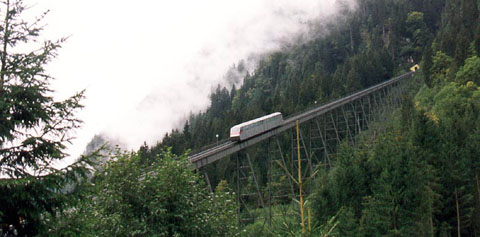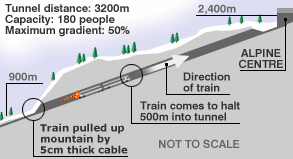Kaprun Disaster
The Kaprun disaster was a fire that occurred in an ascending railway car in the tunnel of the Gletscherbahn 2 railway in Kaprun, Austria, on 11 November 2000. The disaster claimed the lives of 155 people, leaving 12 survivors (10 Germans, 2 Austrians) from the burning car. The victims were skiers on their way to the Kitzsteinhorn Glacier.

The train
The train, the Gletscherbahn 2, was a funicular railway running from Kaprun to the Kitzsteinhorn, opened in 1974. This railway had the unusual track gauge of 946 millimeters, and a length of 3900 meters, of which 3300 meters was through a tunnel. There were two carriages on a single track, with a section allowing the trains to pass each other halfway. One train would carry passengers up the mountain while the other train simultaneously descended the mountain. The carriages each had a maximum capacity of 180 passengers. The tunnel terminated at the main reception centre, called the Alpine Centre.
The unit had its fire extinguishers out of the passengers’ reach in the sealed attendant compartments. No smoke detectors existed on board. The passengers had no method of contacting the attendant. Professor Joseph Nejez, a funicular train expert, said that the designers throughout the years had a perception that a fire could not occur since no fire occurred in a funicular cabin prior to the Kaprun disaster. The train complied with area safety codes, which did not address the systems installed on the train during its 1993 upgrade. The onboard electric power, hydraulic systems, and fan heaters intended for use in homes instead of trains increased the likelihood of fire.
The disaster
On 11 November 2000, 161 passengers and one conductor boarded the funicular train for an early morning trip to the slopes. After the passenger train ascended into the tunnel shortly after 9:00am, the electric heater in the unattended conductor’s cabin at the lower end of the train caught fire, due to a design fault. The fire melted through plastic pipes carrying flammable hydraulic fluid from the braking system, and the resulting loss of fluid pressure caused the train to halt unexpectedly (this was a standard safety feature). The train conductor, who was in the cabin at the upper end of the train (which was the front, since the train was ascending), realised a fire had broken out, reported it to the control centre, and attempted to open the hydraulically operated train doors, but the system pressure loss prevented them from operating. The train conductor then lost contact with the control centre because the fire burned through a power cable running the length of the track, causing a total blackout.
The passengers, by this stage aware of the fire and unable to exit through the doors, attempted to smash the break-resistant acrylic glass windows in order to escape. Eleven passengers from the rear of the train who successfully broke a window followed the advice of another escaped passenger who had been a volunteer fire fighter for 20 years, and travelled downward past the fire and below the smoke.
Many of the still-trapped occupants had by now lost consciousness due to toxic fumes. Eventually, the conductor was able to unlock the doors, allowing them to be manually forced open by the remaining conscious passengers who spilled out into the tunnel and fled upwards and away from the fire. The tunnel acted like a giant chimney, sucking oxygen in from the bottom and rapidly sent the poisonous smoke, heat and the fire itself billowing upwards. All the passengers ascending on foot, as well as the train conductor, were asphyxiated by the smoke and then burned by the raging fire.
The conductor and the sole passenger on the railway’s second train, which was descending the mountain in the same tunnel from above the burning carriage, also died of smoke inhalation. The smoke kept ascending the tunnel, reaching the Alpine Centre located at the top end of the track 2,500 metres away. Two fleeing workers in the Alpine Centre, upon seeing the smoke, alerted employees and customers and escaped via an emergency exit. They mistakenly left the exit doors open, a factor which increased the chimney effect within the tunnel by allowing air to escape upwards more quickly and further intensifying the fire. Meanwhile, the centre was filled with smoke and all except four people escaped the centre. Firefighters reached the centre and saved one of the four, while the other three were asphyxiated.
The twelve survivors of the disaster were the passengers who travelled downhill past the fire at the rear of the train, escaping the upward-rising fumes and smoke.
Nearly one year after the fire, the official inquiry determined the cause was the failure, overheating and ignition of one of the electric heaters installed in the conductor’s compartments that were not designed for use in a moving vehicle. A slow leak of highly flammable hydraulic oil was ignited by the burning heater, which in turn melted the plastic fluid lines further feeding the flames, and also resulting in the hydraulic pressure loss which caused the train to stop and the doors to fail.
Casualties and aftermath
The funicular was never re-opened after the disaster and was replaced by another gondola lift, a 24-person Gletscherjet 1 funitel. The stations were abandoned and the tunnel sealed, and it remains unused today. The victims of the disaster included:[2]
92 Austrians
37 Germans
10 Japanese
8 Americans
4 Slovenians
2 Dutch
1 Briton
1 Czech
On 19 February 2004, Judge Manfred Seiss acquitted all 16 suspects. All suspects – including company officials, technicians and government inspectors – were cleared of criminal negligence. Judge Seiss said there was insufficient evidence to find the suspects responsible for the conditions that led to the blaze. The Austrian Nobel Prize winner Elfriede Jelinek incorporated the disaster in her 2003 play In den Alpen (In the alps).


